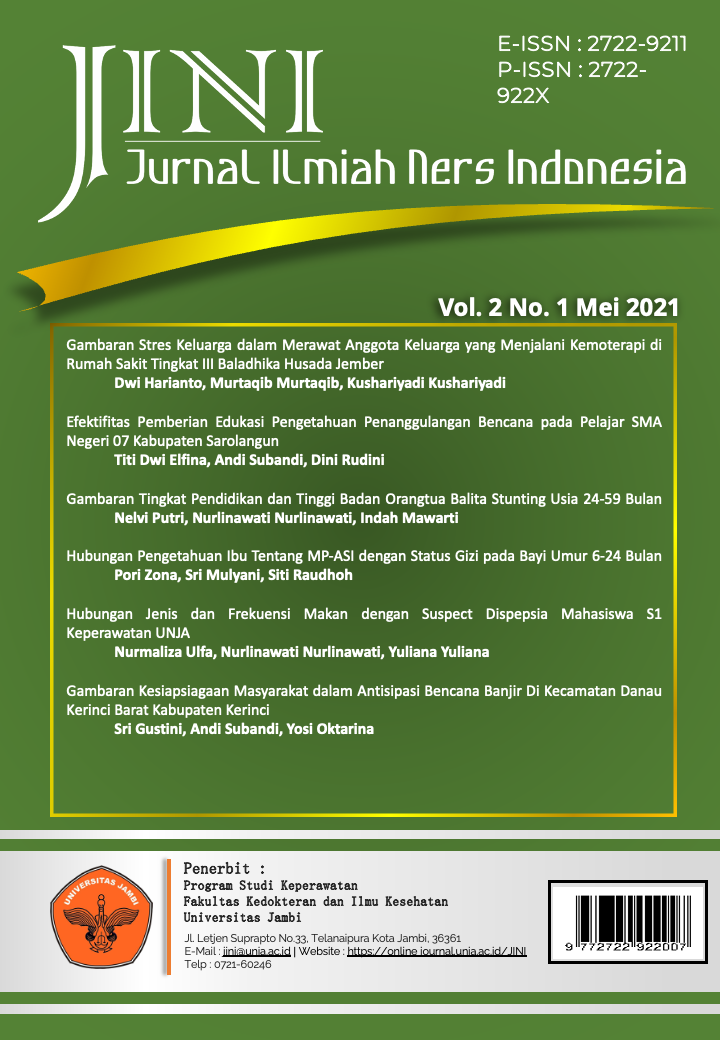Gambaran Tingkat Pendidikan dan Tinggi Badan Orangtua Balita Stunting Usia 24-59 Bulan
DOI:
https://doi.org/10.22437/jini.v2i1.10068Keywords:
Education level, height, stuntingAbstract
Stunting has a large impact on the growth and development of children and also the economy of Indonesia in the future. Stunted toddlers will generally experience obstacles in cognitive and motor development and also have a greater risk for suffering from non- communicable diseases such as diabetes, obesity, and heart disease in adulthood. Parent's level of education and height are the main determinants of stunting. Therefore, the researcher wants to see an overview of the level of education and stunting of parents of stunting toddlers aged 24-59 months in the working area of the Puskesmas Siulak Mukai, Kerinci Regency. This type of research is descriptive research. In determining the number of samples in this study using a total sampling technique that is all parents who have stunting toddlers aged 24-59 months in the working area of the Puskesmas Siulak Mukai Kabupaten Kerinci used as samples with a total sample of 42 stunting toddlers, sampling using the purposive sampling method. Analysis of the data used in this study is univariate analysis. The results showed that the level of education of high school fathers equivalent was 42.9%, the level of education of high school fathers as much as 40.5%, father's height was 55% more than the height of short fathers by 45%, high short maternal body as much as 59.5%. The level of education of parents of high school/equivalent and low maternal height can cause children to grow stunting.
Downloads
References
Aridiyah FO, Rohmawati N & Ririanty M. (2015). Faktor-faktor yang Mempengaruhi Kejadian Stunting pada Anak Balita di Wilayah Pedesaan dan Perkotaan (The Factors Affecting Stunting on Toddlers in Rural and Urban Areas). e-jurnal pustaka kesehatan ;3(1):163-170 p.
Dinkes. (2018). Profil kesehatan Kabupaten Kerinci tahun 2018. Kerinci: Dinas Kesehatan Kabupaten Kerinci;
Juliabdi A. (2014). Metode Penelitian Bisnis. Medan: Umzu Press; 55–56 p.
Kemenkes. (2018). Buku saku pemantauan status gizi tahun 2017. Kementerian Kesehatan Republik Indonesia ;7–11.
Kemenkes. (2018). Buletin Stunting. Kementerian Kesehatan Republik Indonesia ;301(5):1163–78.
Kristianti D. (2018). Hubungan Karakteristik Balita (jenis kelamin, berat badan lahir) dan Tinggi Badan Ibu dengan Kejadian Stunting pada Anak Usia 6-23 Bulan di Wilayah Kerja Puskesmas Jati Makmur Binjai Utara.
Kuntjojo. (2019). Metodologi Penelitian. Kediri: Alfabeta;
Kusuma KE. (2013). Faktor Risiko Kejadian Stunting pada Anak Usia 2-3 Tahun ( Studi di Kecamatan Semarang Timur ). Universitas Deponegoro;
Laala KC dkk. (2019). Hubungan antara tinggi badan orang tua dengan kejadian stunting pada anak usia 24-59 bulan di kecamatan tombatu utara kabupaten minahasa tenggara Jurnal kesehatan masyarakat; 7(4).
Miko A, Al-rahmad AH. (2017). Hubungan Berat Dan Tinggi Badan Orang Tua Dengan Status Gizi Balita Di Kabupaten Aceh Besar. Gizi Indonesia ;40(1):21–34.
Pejaten D & Toyomerto D. (2019). Faktor-faktor kejadian stunting pada balita di wilayah kerja upt puskesmas kramatwatu kabupaten serang. Sekolah Tinggi Kesehatan Faletehan Serang Banten; skripsi
Tim Nasional Percepatan Penanggulangan Kemiskinan. (2017). 100 Kabupaten/Kota Prioritas Untuk Intervensi Anak Kerdil (Stunting). Jakarta: Badan Penelitian dan Pengembangan Kesehatan;
Downloads
Published
How to Cite
Issue
Section
License
Copyright (c) 2021 Jurnal Ilmiah Ners Indonesia

This work is licensed under a Creative Commons Attribution-NonCommercial-ShareAlike 4.0 International License.
Jurnal Ilmiah Ners Indonesia (JINI) memberikan akses terbuka terhadap siapapun agar informasi dan temuan pada artikel tersebut bermanfaat bagi semua orang. Semua konten artikel Jurnal ini dapat diakses dan diunduh secara gratis, tanpa dipungut biaya, sesuai dengan lisensi creative commons yang digunakan.

Ciptaan disebarluaskan di bawah Lisensi Creative Commons Atribusi-BerbagiSerupa 4.0 Internasional.



